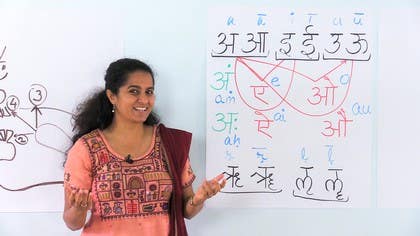Description
About This Video
Transcript
Read Full Transcript
Namaste friends, welcome again. Now we move on to the second step on this journey into the world of Sanskrit sounds, the Sanskrit Varanamala, the Sanskrit alphabet. We have here a representation of the human vocal system, my representation of the human vocal system and we saw that there are five places of pronunciations. We have the throat, the throat or the guttural, then we have the palate and the paratals, we have the roof of the mouth, the center point of the roof of the mouth which is the cerebrals, then we have the point which is behind the teeth or the dentals and then finally we have the fifth point of touch which is the lips or the labials. The Sanskrit letters are arranged in a manner that they correspond to all these different places of touch within our vocal system.
We will start with the vowels and see how they correspond to these different places. The very first vowel in the Sanskrit alphabet is the sound a, it comes from the throat. In terms of sound and the effect of sound, it represents existence itself. What is beautiful about the Sanskrit vowels is that there is a concept of a duration of the sound. So, we have the short sound and then we have the long vowel, the short vowel and the long vowel.
So, we have a which is a single beat and then we also have an a which is twice the length. So, a a, it is the respect of this duration of the vowel that actually gives the music of the language and changing the length of the vowel can sometimes change the entire meaning of the word. Like I'll give you an example, we have the word kala which means art and if you change the vowel and you say kala, it becomes time. So, it becomes very important to know which vowel is long and which one is short. We'll start with the vowels once more with the a, so we have a a, I'd like to just add a short note on the sound a, some people pronounce it as an a and some would pronounce the short a as an a but keeping only one beat.
The Sanskrit language recognises both possibilities. In grammar, they say that there can be a closed sound and an open sound. In the north of India, they would tend to pronounce it more as the short sound, the a, in the south of India, they would tend to pronounce it more as an a or a short a. The reason for keeping it as a short sound is when you say a word like namaste, one would not say namaste. So the short pronunciation or the closed version of the sound is how the sounds are pronounced in the different words of the Sanskrit language.
We'll do it with the a, so we have a a, the second sound is the e, they form part of the primary vowels of the Sanskrit alphabet. So the e, we have a short palatal sound e, ee, ee. The third primary sound in the vowel system is the u, it's a labial sound. So it's like almost as if you're dividing the human vocal system into three parts. We have the a, a, ee, ee, u, u.
Now I'd also like to represent this on our hand. We assign the first three primary sounds to the first three fingers a, a, ee, ee, u, u. These three vowels are the most commonly used vowels but then we also have two other simple vowels which correspond to the cerebral as well as to the dental parts of our vocal system. The first is the cerebral which is the r, r, so gently place your tongue below the centre of your roof of your mouth and say r, r, we have words like rishi, ritam that start with the sound r, so it is r, r, r, next we have the sound by placing the tongue just slightly behind the tip of your teeth, it's l, l, l, it's a little complicated. The good news is that these sounds don't get used too often but they form part of the system in order to keep the completeness or the perfection of the system.
So let's do these five sounds together, a, a, ee, ee, u, u, r, l, l, l, we have the simple vowels using these different sounds and the different parts of the vocal system. The next few letters we can consider as combined vowels, we have the sound a and we have the sound e, when you try to go systematically from a to e, when you roll the sound out from a to e, we get the sound a, I'll show you, a, a, ee, ee, so in between the a and the e we get the vowel a and I normally like to show it with this action, it's like the accent in the French language, so a that's the next sound we have, next vowel and then we get a combination of a and e slow down, it's the I, so we have a, I, now let's do it from the beginning till there, a, a, ee, ee, u, u, r, r, l, l, ee, I, the following sound is between the a and the u, when you try and roll the sound out from the a to the u we get the o, so go from a, o, o, so the following sound is o followed by a, o, now we'll try and see that all together, a, a, ee, ee, u, u, r, l, r, l, ee, I, o, ao and then we have two sounds called anuswara, it's the m, it's the nasal sound which is um, it's a combination of the letter a with the dot or with the anuswara called um, the sound is also sometimes pronounced as un, both are valid, so um or un and ah, the ah, the two dots it's often represented by two dots is known as the visarga, the final aspirated sound, so um, ah, let's do the vowels all again and I suggest that as you do these sounds you try and exaggerate your mouth as much as you can so that when you are registering the sound for the first time it is registered in its completeness within yourself, so it's an ah, ah, ee, ee, u, u, l, l, l, ee, i, u, ao, um, ah, you see why Sanskrit is known as a very de-stressing language because it is full of this ah, ah, ah, so it acts as a kind of a natural pranayama, we'll discover more about this as we look into the Sanskrit consonants.
Mother Tongue: The Sound of Sanskrit
Comments
shubhamastu - may well-being be yours !! :)
Glad that this presentation is useful for you! Enjoy discovering your vocal system and mouth :)
You need to be a subscriber to post a comment.
Please Log In or Create an Account to start your free trial.


















